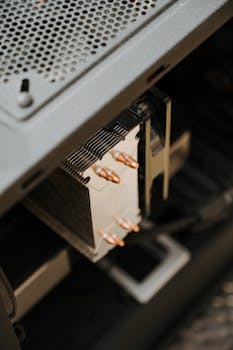
Spending hundreds on a CPU, then skimping on thermal paste? That cheap choice could cost you dearly. Reports are surfacing of serious issues caused by low-quality thermal paste, potentially damaging your processor. Learn how to identify and avoid this costly mistake to protect your PC.
Is Your PC Smelling Like Vinegar? It Could Be Your Thermal Paste!
Thermal paste is a crucial component in any computer, bridging the gap between the CPU (Central Processing Unit) and the heatsink to ensure proper heat dissipation. Using high-quality thermal paste is vital to prevent CPU overheating, which can lead to performance throttling or even permanent damage. While it's a relatively inexpensive component, opting for a cheap paste can have disastrous consequences.
The Hidden Danger of Cheap Thermal Paste
Many builders focus on high-end components like the CPU and GPU, sometimes overlooking the importance of the thermal paste. Saving a few dollars on this small item can seem tempting, but the potential risks far outweigh the savings. The consequences of using a substandard thermal paste can range from decreased performance due to overheating to complete hardware failure.
Real-World Examples of Thermal Paste Failure
Recently, reports have emerged of CPU failures linked to specific brands of thermal paste. One example involves users experiencing issues with Amech SGT-4 thermal paste (also known as Aimac in some regions). Users reported the paste melting, causing the CPU and heatsink to fuse together, making separation incredibly difficult. Others described a pungent, vinegar-like smell emanating from their PCs, followed by signs of corrosion on the processor due to acidic reactions.
Expert Confirmation and the Culprit Ingredient
These user reports were investigated and confirmed by Igor Wallossek, a computer technician from Igor's Lab. His analysis revealed that Amech SGT-4 thermal paste uses PMDS as a base, but instead of standard silicone, it contains acetoxy-crosslinked RTV silicone. The suspected culprit is methyl triacetoxysilane, a highly reactive compound that releases acetic acid upon exposure to moisture. This reaction leads to copper oxidation, hence the vinegar-like odor.
Furthermore, this crosslinking process causes the paste to harden over time, becoming sticky and adhering strongly to the heatsink. This creates a situation where "immense separating force" is required to detach the surfaces, potentially damaging the CPU in the process.
Identifying the Signs of Bad Thermal Paste
Knowing what to look for can help you identify potential issues with your thermal paste before it's too late. Here are some key indicators:
- Unusual Odor: A strong vinegar-like smell is a major red flag. This indicates that the paste is breaking down and releasing harmful chemicals.
- High CPU Temperatures: If your CPU is running hotter than usual, even under normal workloads, it could be a sign of poor thermal conductivity.
- Performance Throttling: Overheating can cause your CPU to reduce its clock speed to prevent damage, resulting in noticeable performance drops.
- Hardened or Dried-Out Paste: When you remove the heatsink, the paste should be pliable. If it's hard, cracked, or dried out, it's not doing its job effectively.
- Corrosion: Look for signs of corrosion on the CPU or heatsink, especially around the contact area.
Choosing the Right Thermal Paste: A Practical Guide
Selecting a high-quality thermal paste is an investment in the longevity and performance of your computer. Here's what to consider:
- Reputable Brands: Stick to well-known and trusted brands like Arctic, Noctua, Thermal Grizzly, and Cooler Master. These companies have a proven track record of producing reliable thermal solutions.
- Read Reviews: Before purchasing, research online reviews and comparisons to see how different pastes perform in real-world scenarios.
- Consider Thermal Conductivity: Look for pastes with a high thermal conductivity rating (measured in W/mK). A higher rating indicates better heat transfer.
- Application Method: Choose a paste that's easy to apply. Some pastes come with applicators or stencils to ensure even coverage.
- Don't Overspend: While quality is important, you don't need to buy the most expensive paste on the market. A mid-range paste from a reputable brand will often provide excellent performance.
Practical Tips for Applying Thermal Paste
Applying thermal paste correctly is just as important as choosing the right product. Here are some helpful tips:
1. Clean Surfaces: Before applying new paste, thoroughly clean both the CPU and heatsink surfaces with isopropyl alcohol and a lint-free cloth. This removes any old paste or residue.
2. Apply Sparingly: Use a small amount of paste – typically a pea-sized dot in the center of the CPU. Too much paste can be just as bad as too little.
3. Even Distribution: The pressure from the heatsink will spread the paste evenly. Avoid manually spreading the paste, as this can introduce air bubbles.
4. Secure the Heatsink: Carefully align and secure the heatsink to the CPU, ensuring it's properly seated and making good contact.
5. Monitor Temperatures: After reassembling your system, monitor your CPU temperatures to ensure they're within a safe range.
Conclusion: Protect Your Investment
The lesson here is clear: don't compromise on the quality of your thermal paste. Spending a few extra dollars on a reputable brand can save you from potential headaches and costly hardware failures. By understanding the risks associated with cheap thermal paste and following the tips outlined in this article, you can protect your investment and keep your computer running smoothly for years to come. If you notice a strange smell coming from your PC, especially a vinegar-like odor, investigate immediately. It could be a sign of a serious problem that needs to be addressed before it causes irreversible damage.
